Posted under Bali
Happy to be back in Ubud, we commenced our usual daily activities of trekking, reading, dining and drinking. Morning tea arrived on our patio at 7:30 sharp every day and I found myself waking naturally around seven and reading quietly in bed until the clinking of tea cups signaled the official start of the day. Even Aaron was getting into the groove of total relaxation – a marvelous feat for someone with chronic multi-taskitis. We were achieving balance with minimal effort; merely the will to succumb to Ubud’s centripetal force, pulling us gently back to the middle.
With a full tank of petrol and an itch to explore, we cruised around on the moped, revisiting some of the places to which we had walked before and dodging jaywalking chickens in the process. Every time I saw a chicken waddle across the road, I silently questioned its motives. Why did the chicken cross the road? I would leave Ubud as yet unsettled on the subject. I have enough trouble figuring people out; chicken motives remain a total mystery.
Aaron’s retainers were supposed to be ready that day and, since we were in the neighborhood, we decided to stop by the Sayan Aesthetic Institute to check the status. The same friendly attendant from our first visit informed us that the retainers were due to arrive later that afternoon and he would drop them off at our hotel. We paused to admire once again the magnificent painting that hung behind the attendant’s desk. It was an original oil by a Balinese painter; the subjects reminded us of Degas’ dancers. During the three days since I had first laid eyes on the painting, my thoughts kept returning to it and, after seeing it a second time, Aaron began to show a similar affinity. At the risk of sounding cliché, the painting spoke to us like no piece of artwork ever had. I wrote down the author’s name and snapped a photo of the painting. With Ubud being the cultural center of Bali, we thought it likely that the artist might have a gallery in the city. We did some online searches and inquired at a Balinese art museum. We found only snippets of information, indicating that some of the artist’s work had recently sold at auction in Jakarta, but the trail ended there. I resolved to put the painting out of my mind.
Aaron’s retainers were delivered later that afternoon, as promised. The attendant followed up by phone the next morning on their fit. The bottom retainer did, in fact, need some adjustment and we were invited to stop into the office in the afternoon. Our day began, like many others in Ubud, with morning tea followed by a long walk. The walking itinerary described in our guide book covered a distance of ten kilometers with a mix of urban and rural terrain. We walked the first couple of hours on paved roads, with no sidewalks and unimpressive scenery. Still, it felt good to stretch our legs and get some exercise. After hours in the hot sun, we reached the landmark – a carved stone wall hardly worthy of mention – that was supposed to give way to a trail through the rice fields, which would be the home stretch of our journey. When we reached the wall, a local gatekeeper informed us that the trail was closed to tourists for a big Balinese ceremony. This news did take the wind from our sails though we were not overly surprised as we’ve discovered that the Balinese have some kind of ceremony or celebration almost every day of the week. Wilted and weary, we backtracked a ways to the main road and walked along until we spied a narrow trail leading into the jungle. My bushwalking tolerance was fading fast and I suggested hailing a taxi to take us back to the hotel. Aaron had other ideas. “Fine,” he said, stubbornly, “I’ll meet you back at the hotel.” I was hot, tired and exasperated but my curiosity coupled with the challenging tone of Aaron’s voice got the better of me and I followed my compass down a muddy trail into the jungle. The difficulty in trekking through jungle and/or rice fields is that the trails are unmarked. Even when you think that you are following written instructions verbatim and your natural compass tells you that you are heading in the right direction, there is room for error.
Grass on both sides of the narrow path made my bare legs itch as we followed it further and further down the hill and away from the main road. I tried not to think about the bugs. Aaron walked confidently ahead on the path, hopeful that we would intersect the rice field trail from another direction and find our way home. We soon came upon a lone Balinese farmer who was quite surprised to see two tourists so deep in the jungle. The farmer spoke no English whatsoever but still managed to communicate that the only way back to Ubud was back on the main road. He gestured toward a big house at the top of the hill with a metal staircase extending about halfway down the steep slope. We thanked the man and slowly made our way toward the staircase only to find it gated and locked. The only other option was to backtrack again on the trail…or so I thought. Again, Aaron had other ideas.
The property surrounding the house was fortified with fierce-looking barbed wire but there appeared to be a lightly-trodden path around the right side. Aaron led the way up the narrow, steep, mud-slick path with dense jungle on one side and barbed wire on the other. I could touch both without fully extending my arms. Morning rains had left mud everywhere and we had to take our time climbing up, holding onto tree branches, exposed roots, clumps of jungle grass or whatever we could find to keep from sliding back against the razor-sharp metal barbs. Despite these conditions and their associated insects, I managed to keep my trucker’s mouth in check…until we reached the top of the hill and discovered that the barbed wire fence extended along the top as well, leaving us no way to go but back down. After a five-second meltdown that would have to have been blipped out entirely for public television, I regained my composure and we started back down the hill. Despite our extreme caution, Aaron managed to slip on a muddy patch and cut his hand on the barbed wire. It was not a deep cut but bloody nonetheless and Aaron spent the next bloody hour as the poster child for travel vaccinations.
We re-emerged from our failed detour, bloodier, muddier and sweatier but no worse for the wear; the farmer spotted us, and pointed to a tiered retaining wall alongside the locked staircase leading up to the house. Without further hesitation, we scaled the walls and trespassed onto the obviously private property, half-expecting someone to come charging outside with a shotgun. But this was Bali, not the Wild West, and we made it to the main road with no problem. My legs and shoes were covered with mud and grass; the seat of Aaron’s shorts and the back of his right calf were smeared thickly with mud; we were both soaking with sweat in the sticky tropical heat. This time, Aaron humored me by hailing a bemo – the light blue converted vans that serve as cheap public transport – and we rode silently back to Ubud. It was quite an adventure.
Back at the hotel, we showered and relaxed for a while before heading out for a late lunch in town. After that, we made our way to the Sayan Aesthetic Institute to get Aaron’s retainer adjusted…and to see the painting again. By this time, we had had several discussions about the painting, gauged similar interest, and tossed around some numbers between ourselves. As we dismounted our moped and walked across the parking lot, Aaron suggested that we make a bid, even if it was a lowball offer. I was pessimistic and intimidated. I am not a negotiator by nature. The attendant, excited by our interest, also suggested that we state a price that he could take to the owner and start the negotiation. Aaron and I exchanged looks, reading each other’s eyes (we’ve gotten pretty good at this by now), and after a few moments pause, I opened the negotiation.
With Aaron’s retainer satisfactorily adjusted, we continued our afternoon with some last-minute shopping in town since we were scheduled to depart from Ubud the following day. When we returned to the hotel, there was a message from the attendant that he would stop by our place later that evening. He arrived shortly thereafter and the three of us sat outside on our cottage patio. After twenty or so minutes of decidedly awkward negotiations, we actually reached an agreement! A few more moments of awkwardness passed, followed by a wave of surrealism. The attendant left, promising to see us in the morning, and Aaron and I just sat, staring at each other for a long while. Did that really just happen? Did we really just commit to buying a large and expensive painting with no house or jobs to speak of? Our hearts raced with a strange combination of panic and excitement. We could speak of little else that night until sleep finally came.
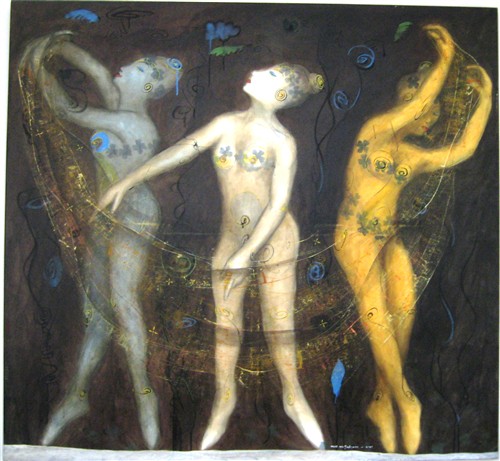
We arrived at the office around 9:30 on a gray and rainy morning and were told that our painting was in the boutique and we could complete the transaction there. The very extravagant boutique was several hundred meters up the road so we took the moped there and found the painting propped up against a display table just inside the doorway. We had requested that the canvas be removed from its wooden backing and rolled into a shipping tube. The painting had caused some excitement in the boutique that morning and there were five or six staff members collaborating to remove the staples and roll it carefully into a length of PVC pipe which had been cut for our specific purpose. The whole process took almost two hours and then we were on our way. The painting was ours! The PVC pipe and end caps fully enclosed the fragile canvas, protecting it from the rain. I held it awkwardly, because of its length and weight, on the back of the moped as Aaron navigated the wet roads. When we arrived at the hotel, our car and driver were waiting to take us back to Kuta, where we would spend our last two nights in Bali.
The ride was quick and easy and we rode into Kuta on a sunny afternoon with no hotel reservation. The driver waited in the car with our bags while we walked around looking for cheap accommodation. Kuta has many narrow lanes which are nearly impossible for a car to navigate. We found a row of four budget hotels along one of the lanes and checked into the cheaper of the two rooms that we looked at – rock, paper, scissors had worked in Aaron’s favor this time, resulting in a room with a cold shower that saved us $10/night. Both nights, we spent the savings on massages so I couldn’t exactly complain.
In a final mad dash to the finish, we rented a moped and sped through the streets of Kuta, searching for the DHL office. After a series of wrong turns, we slipped through the doors of DHL with literally two minutes to spare before the office closed on a Friday afternoon. We spent our last days in Kuta as beach bums. Aaron surfed while I caught up on some reading or listened to music, staring dreamily out to sea. At times, I thought that I was daydreaming, only to blink and discover that the dream was real.
Leaving Bali was something that I’d never really contemplated. It is an exotic destination, like Tahiti or Bora Bora, which many people add to their list of dream vacations and, if they happen to make it there during one of their two weeks of yearly vacation, divide their time equally between the posh resorts and beaches of the southern peninsula. I suspected that we would do the same but, surprisingly, we found ourselves drawn away from the beach to beautiful Ubud, where skin and sin are replaced by art, music, tranquility and rural simplicity. In Ubud, I found myself thinking almost daily, I could live here. Strangely, as we rode toward the airport in Denpasar, I was not overcome with the sad nostalgia that I have felt about other places we’ve been and gone. Most of those places I will never see again. To Bali I will return often, if only in my mind. I will be somewhere, sometime, with a happy, distant expression on my face. Someone will ask me what I’m thinking about. “Oh, nothing”, I’ll say with a smile.
Comments Off on The Painting

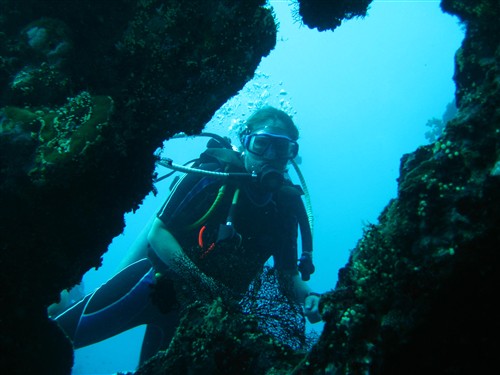 There is an eeriness that surrounds all sunken ships, similar to the feeling a child gets while walking through a graveyard, her young mind swimming with ghost stories. Shipwrecks all have ghost stories and, through the underwater silence, I always try to listen for them. They are not the chronological details of reference materials but rather the resonating cries of young shipmen; brave soldiers praying to God to return them to their wives and children, struggling against fate with all of their might; a captain summoning the courage to go down with the ship. Those are the stories I imagine I hear, stories that touch my heart and send shivers down my spine.
There is an eeriness that surrounds all sunken ships, similar to the feeling a child gets while walking through a graveyard, her young mind swimming with ghost stories. Shipwrecks all have ghost stories and, through the underwater silence, I always try to listen for them. They are not the chronological details of reference materials but rather the resonating cries of young shipmen; brave soldiers praying to God to return them to their wives and children, struggling against fate with all of their might; a captain summoning the courage to go down with the ship. Those are the stories I imagine I hear, stories that touch my heart and send shivers down my spine.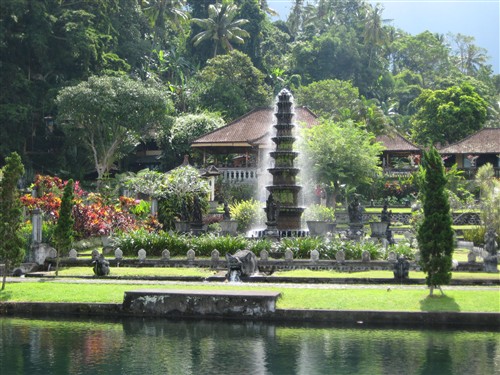 Our next stop was a famous water palace, called Taman Tirta Gangga, meaning Water of the Ganges. Our guide book made little mention of it but it had been recommended highly by a fellow diver. Unsure what to expect, we walked through the requisite vendor stalls and bought two tickets at the entrance. Our first glimpse of the water palace took our breath away. The grounds were composed of sparkling pools, their glassy surfaces almost perfectly still on the breezeless day. Landscaped stone walkways, an ornate footbridge, statues and fountains accented the pools and gave the grounds the appearance of a watery playground. We were delighted and skipped like children over the walkways and stepping stones. Our favorite pool was stocked with carp and had a maze of stepping stones within it that made you feel as though you were walking on water. There was no palace on the property at all but rather an old temple and a posh hotel and restaurant so we took our time through the magnificent grounds and then continued on our way to Ubud.
Our next stop was a famous water palace, called Taman Tirta Gangga, meaning Water of the Ganges. Our guide book made little mention of it but it had been recommended highly by a fellow diver. Unsure what to expect, we walked through the requisite vendor stalls and bought two tickets at the entrance. Our first glimpse of the water palace took our breath away. The grounds were composed of sparkling pools, their glassy surfaces almost perfectly still on the breezeless day. Landscaped stone walkways, an ornate footbridge, statues and fountains accented the pools and gave the grounds the appearance of a watery playground. We were delighted and skipped like children over the walkways and stepping stones. Our favorite pool was stocked with carp and had a maze of stepping stones within it that made you feel as though you were walking on water. There was no palace on the property at all but rather an old temple and a posh hotel and restaurant so we took our time through the magnificent grounds and then continued on our way to Ubud.
 We checked into Nick’s Pension – a complex of two-story Balinese-style cottages surrounding a small rice field. It was located along a quiet side street, across from a larger rice farm, giving it the rural charm of a tropical hideaway. As we settled into our cottage, afternoon tea was served on our shaded patio – a lovely touch, we thought. Weary from our surfing exploits earlier that morning in Kuta, we dropped everything and sat down to enjoy the tea in the lush garden setting of the property, meticulously kept by an abundant staff. The grounds were adorned with ogre-like stone-carved statues decorated good-humoredly with fresh, bright red flowers behind their ears.
We checked into Nick’s Pension – a complex of two-story Balinese-style cottages surrounding a small rice field. It was located along a quiet side street, across from a larger rice farm, giving it the rural charm of a tropical hideaway. As we settled into our cottage, afternoon tea was served on our shaded patio – a lovely touch, we thought. Weary from our surfing exploits earlier that morning in Kuta, we dropped everything and sat down to enjoy the tea in the lush garden setting of the property, meticulously kept by an abundant staff. The grounds were adorned with ogre-like stone-carved statues decorated good-humoredly with fresh, bright red flowers behind their ears. Our favorite Indonesian dish is nasi goreng – fried rice with chicken and prawns, topped with a fried egg and accompanied by prawn crackers and skewers of chicken doused in peanut sauce. Nasi goreng is offered in most restaurants for breakfast, lunch and dinner and, on occasion, we have had it for all three. There are many small, family-run eateries, called warungs, which usually have four or five small tables and cheap Indonesian eats, though many proprietors in central Ubud have commercialized the warung concept to a trendier and pricier level.
Our favorite Indonesian dish is nasi goreng – fried rice with chicken and prawns, topped with a fried egg and accompanied by prawn crackers and skewers of chicken doused in peanut sauce. Nasi goreng is offered in most restaurants for breakfast, lunch and dinner and, on occasion, we have had it for all three. There are many small, family-run eateries, called warungs, which usually have four or five small tables and cheap Indonesian eats, though many proprietors in central Ubud have commercialized the warung concept to a trendier and pricier level.

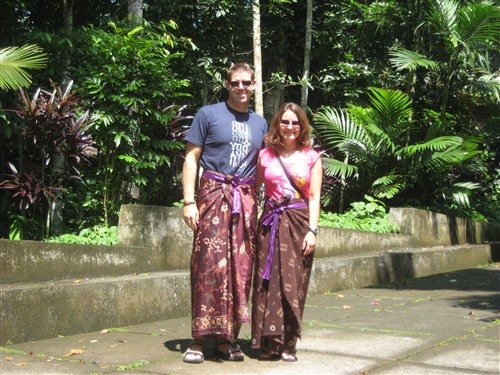 Pura Luhur Batukau was tucked into a tropical mountain forest; the cool, misty air bathed the temple grounds in an ethereal glow. Because of the temple’s remote location, the noise of tourists and touts is noticeably absent and replaced by quiet serenity. We paid a nominal fee to enter and were requested to wear the sarongs provided in the small baskets while on the temple grounds. A sign at the entrance listed restrictions for entry: pregnant women, menstruating women, and children with baby teeth among others were forbidden. Only Balinese were permitted entry into the inner sanctum so we walked the manicured gardens around the exterior and ventured a few steps through the main entryway on the heels of the only other pair of tourists whose guide ushered them a few steps inside. There were marvelous stone carved statues covered in rich green mosses which only added to their aged beauty. Some were adorned with fresh, brightly colored flowers.
Pura Luhur Batukau was tucked into a tropical mountain forest; the cool, misty air bathed the temple grounds in an ethereal glow. Because of the temple’s remote location, the noise of tourists and touts is noticeably absent and replaced by quiet serenity. We paid a nominal fee to enter and were requested to wear the sarongs provided in the small baskets while on the temple grounds. A sign at the entrance listed restrictions for entry: pregnant women, menstruating women, and children with baby teeth among others were forbidden. Only Balinese were permitted entry into the inner sanctum so we walked the manicured gardens around the exterior and ventured a few steps through the main entryway on the heels of the only other pair of tourists whose guide ushered them a few steps inside. There were marvelous stone carved statues covered in rich green mosses which only added to their aged beauty. Some were adorned with fresh, brightly colored flowers.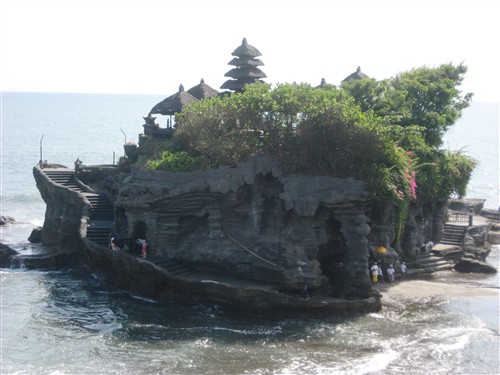 We drove around to the parking lot of Pura Tanah Lot – the most photographed and commercialized temple on the island. We purchased our tickets and walked through a large area of souvenir and refreshment stalls before reaching the entrance. Set on Bali’s west coast, the sea temple is reputedly thronged with tourists every day at sunset but it was relatively quiet in the early afternoon. The temple is built on a rock about fifty meters off the mainland. At low tide, you can walk across the shallow water to the temple although, again, non-Balinese are not permitted to enter. We found it slightly disheartening to pay an entry fee to a temple we could not enter. Still, the outside of Pura Tanah Lot was impressive. It had a mystical, storybook appeal with winding stone staircases leading into dark, mysterious caverns. There were several outdoor restaurants on the cliff overlooking the temple and it would have been a lovely place to watch the sunset but we were happy to avoid the crowds and catch the sunset on Kuta Beach instead.
We drove around to the parking lot of Pura Tanah Lot – the most photographed and commercialized temple on the island. We purchased our tickets and walked through a large area of souvenir and refreshment stalls before reaching the entrance. Set on Bali’s west coast, the sea temple is reputedly thronged with tourists every day at sunset but it was relatively quiet in the early afternoon. The temple is built on a rock about fifty meters off the mainland. At low tide, you can walk across the shallow water to the temple although, again, non-Balinese are not permitted to enter. We found it slightly disheartening to pay an entry fee to a temple we could not enter. Still, the outside of Pura Tanah Lot was impressive. It had a mystical, storybook appeal with winding stone staircases leading into dark, mysterious caverns. There were several outdoor restaurants on the cliff overlooking the temple and it would have been a lovely place to watch the sunset but we were happy to avoid the crowds and catch the sunset on Kuta Beach instead. On our final morning in Kuta, Aaron decided to take a surfing lesson. He had been talking about surfing since South Africa and Kuta just seemed like the right place. We set out early for the beach. I had no interest in surfing – I’m still convinced that Jaws is waiting to mistake me for a seal – but I went along anyway in the capacities of family photographer and entourage. Aaron rented a board on the beach and started his lesson immediately with a few exercises in the sand. Five minutes later, he and his young Balinese instructor were headed for the waves. He got up on his third attempt and several times after that for the next hour. He took a short break and then went out again until I gave him the signal that it was time to go shower and check out of the hotel. He had a great time and I could tell by his big smile that a new surfer was born.
On our final morning in Kuta, Aaron decided to take a surfing lesson. He had been talking about surfing since South Africa and Kuta just seemed like the right place. We set out early for the beach. I had no interest in surfing – I’m still convinced that Jaws is waiting to mistake me for a seal – but I went along anyway in the capacities of family photographer and entourage. Aaron rented a board on the beach and started his lesson immediately with a few exercises in the sand. Five minutes later, he and his young Balinese instructor were headed for the waves. He got up on his third attempt and several times after that for the next hour. He took a short break and then went out again until I gave him the signal that it was time to go shower and check out of the hotel. He had a great time and I could tell by his big smile that a new surfer was born. We arrived in the late evening and stepped out into the breezy night air to find a friendly face with a sign bearing our name – always a welcome sight in a new country. The drive to our hotel in Legian, just north of Kuta, provided flashing glimpses of upscale resort hotels with patios bathed in incandescent glow; a startlingly ubiquitous presence of “culture Americana” with all of the usual suspects – McDonald’s, Starbucks, KFC, Dunkin’ Donuts – and random others. It was the face of a tourists’ haven, the likes of which we had not seen since Thailand. In the dark of night, I might easily have mistaken it for an American beach town but eventually the bright lights gave way to narrower streets and alleyways crowded with vendor stalls and smaller, locally-owned businesses. Our hotel – Sayang Maha Mertha – was tucked inconspicuously into the corner of two quiet alleys. Between the hotel and the beach – a ten-minute walk – lay every type of shop and service that we might need: laundry, tailor, transport, tours, garment and trinket shops, and enough restaurants and bars as to avoid repetition in a much longer stay than our intended four nights.
We arrived in the late evening and stepped out into the breezy night air to find a friendly face with a sign bearing our name – always a welcome sight in a new country. The drive to our hotel in Legian, just north of Kuta, provided flashing glimpses of upscale resort hotels with patios bathed in incandescent glow; a startlingly ubiquitous presence of “culture Americana” with all of the usual suspects – McDonald’s, Starbucks, KFC, Dunkin’ Donuts – and random others. It was the face of a tourists’ haven, the likes of which we had not seen since Thailand. In the dark of night, I might easily have mistaken it for an American beach town but eventually the bright lights gave way to narrower streets and alleyways crowded with vendor stalls and smaller, locally-owned businesses. Our hotel – Sayang Maha Mertha – was tucked inconspicuously into the corner of two quiet alleys. Between the hotel and the beach – a ten-minute walk – lay every type of shop and service that we might need: laundry, tailor, transport, tours, garment and trinket shops, and enough restaurants and bars as to avoid repetition in a much longer stay than our intended four nights.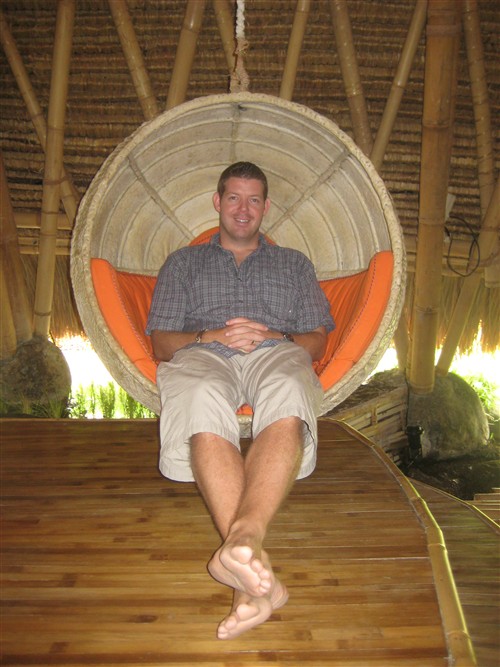 We arrived at 11:30 and began with a private shopping hour in the showroom – a tall, steep-pitched structure made of bamboo and thatch and built over a rice field. I could sense Aaron starting to sweat and justifiably so. We have spent the past eight months shedding our shallow materialism, one layer at a time, but get me into a room full of shiny, sparkling pretty things and, in two seconds, I regress to the former shameless victim of American consumerism whose gluttonous desires I’ve worked so hard to squash. Oh, the humanity! Only this time, I don’t have a job. My husband doesn’t have a job. Our sole source of current income is the unimpressive interest rate on our ever-shrinking pot of travel money. These facts alone should cause a rational person to say “Thanks, but no thanks” to the private shopping hour to begin with but the gleam in my eyes, reflecting off the hammered gold of the Palu collection blinded me to all rationality I might otherwise have been able to muster. What is it with women and the forbidden fruit? Fine jewelry is like a drug – the more you get, the more you want.
We arrived at 11:30 and began with a private shopping hour in the showroom – a tall, steep-pitched structure made of bamboo and thatch and built over a rice field. I could sense Aaron starting to sweat and justifiably so. We have spent the past eight months shedding our shallow materialism, one layer at a time, but get me into a room full of shiny, sparkling pretty things and, in two seconds, I regress to the former shameless victim of American consumerism whose gluttonous desires I’ve worked so hard to squash. Oh, the humanity! Only this time, I don’t have a job. My husband doesn’t have a job. Our sole source of current income is the unimpressive interest rate on our ever-shrinking pot of travel money. These facts alone should cause a rational person to say “Thanks, but no thanks” to the private shopping hour to begin with but the gleam in my eyes, reflecting off the hammered gold of the Palu collection blinded me to all rationality I might otherwise have been able to muster. What is it with women and the forbidden fruit? Fine jewelry is like a drug – the more you get, the more you want. With renewed enthusiasm, I began circling the displays again. There were so many beautiful things. My natural (inherited?) affliction of champagne taste tangled with my desire not to take advantage of Aaron’s generosity, sparking a stalemate of indecision. My husband knows me like the back of his hand and sensed my plight. Both to assuage my guilt and hedge against the potential damage, he suggested a round of rock, paper, scissors – an elementary but effective way of decision-making. He suggested the following terms: if I won, I could guiltlessly take home any single piece in the showroom but, if he won, I got nothing. I’ve never been much of a gambler – a decidedly positive trait passed down from my father – so, at first, this seemed like a bad deal for me since I was technically already authorized to make a purchase. But in the glitter and gleam of gold, silver and precious stones, I somehow became that greedy game show contestant who puts her big winnings on the line to go for the grand prize. I went for it. My heart was racing as was Aaron’s, I’m sure. One, two, three! Tie: rock-rock. One, two, three! Tie: paper-paper. Madness! On what would become the third and tie-breaking round, my paper covered Aaron’s rock and the crowd (inside my head) went wild! I could hardly contain my excitement. I wanted to scream “The world is mine!”
With renewed enthusiasm, I began circling the displays again. There were so many beautiful things. My natural (inherited?) affliction of champagne taste tangled with my desire not to take advantage of Aaron’s generosity, sparking a stalemate of indecision. My husband knows me like the back of his hand and sensed my plight. Both to assuage my guilt and hedge against the potential damage, he suggested a round of rock, paper, scissors – an elementary but effective way of decision-making. He suggested the following terms: if I won, I could guiltlessly take home any single piece in the showroom but, if he won, I got nothing. I’ve never been much of a gambler – a decidedly positive trait passed down from my father – so, at first, this seemed like a bad deal for me since I was technically already authorized to make a purchase. But in the glitter and gleam of gold, silver and precious stones, I somehow became that greedy game show contestant who puts her big winnings on the line to go for the grand prize. I went for it. My heart was racing as was Aaron’s, I’m sure. One, two, three! Tie: rock-rock. One, two, three! Tie: paper-paper. Madness! On what would become the third and tie-breaking round, my paper covered Aaron’s rock and the crowd (inside my head) went wild! I could hardly contain my excitement. I wanted to scream “The world is mine!” After the tour, it was time to pick my prize. I’d circled the showroom several times already. At lunch, most of the female employees were dripping with John Hardy jewelry and one of them had worn a small silver bracelet that was simple and pretty. With carte blanche to choose anything I wanted, I chose a similar small bracelet (notably one of the least expensive items on display), much to Aaron’s surprise. I liked it because I can wear it while traveling without worrying about getting mugged…and I earned some brownie points with my relieved husband, which will undoubtedly be leveraged at the appropriate time. I walked out of John Hardy’s showroom happy as a fat kid in a candy shop, my new treasure already shimmering in the afternoon sun.
After the tour, it was time to pick my prize. I’d circled the showroom several times already. At lunch, most of the female employees were dripping with John Hardy jewelry and one of them had worn a small silver bracelet that was simple and pretty. With carte blanche to choose anything I wanted, I chose a similar small bracelet (notably one of the least expensive items on display), much to Aaron’s surprise. I liked it because I can wear it while traveling without worrying about getting mugged…and I earned some brownie points with my relieved husband, which will undoubtedly be leveraged at the appropriate time. I walked out of John Hardy’s showroom happy as a fat kid in a candy shop, my new treasure already shimmering in the afternoon sun.